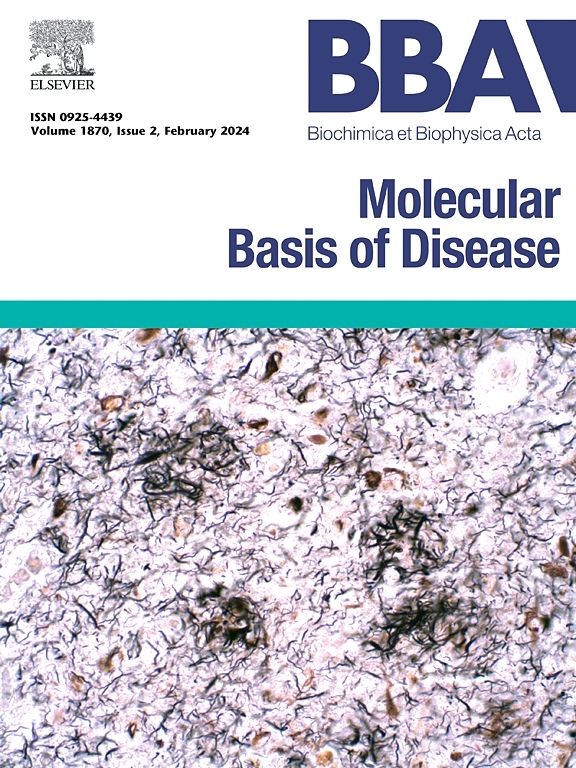Rbm39 ameliorates metabolic dysfunction-associated steatotic liver disease by regulating Apob and Fabp4
IF 4.2
2区 生物学
Q2 BIOCHEMISTRY & MOLECULAR BIOLOGY
Biochimica et biophysica acta. Molecular basis of disease
Pub Date : 2025-03-26
DOI:10.1016/j.bbadis.2025.167815
引用次数: 0
Abstract
Excessive hepatic lipid accumulation is the hallmark of metabolic dysfunction-associated steatotic liver disease (MASLD), yet its underlying mechanisms still not fully understood. In this study, we identified RNA binding motif protein 39 (Rbm39) as a key modulator of hepatic lipid homeostasis during MASLD progression. To establish in vivo MASLD model, mice were fed either a high-fat diet (HFD) or a Gubra-Amylin NASH (GAN) diet. We employed adeno-associated virus to manipulate Rbm39 expression levels to assess its role in MASLD. Transcriptome analysis was conducted to pinpoint the genes targeted by Rbm39. Western blot, RT-PCR, dual-luciferase reporter gene assays, and alternative splicing analysis were utilized to delve into the molecular mechanisms. Our results showed that Rbm39 expression was notably decreased in the livers of MASLD mice. Knockdown of hepatic Rbm39 aggravated HFD-induced hepatic steatosis and GAN diet-induced MASH, along with a notable decrease in serum lipid levels. Conversely, overexpression of Rbm39 attenuated MASLD development and progression. RNA sequencing data analysis indicated that Rbm39 regulated the expression of apolipoprotein B (Apob) and fatty acid-binding protein 4 (Fabp4), both of which are crucial for lipid transport. Mechanistically, Rbm39 enhanced the transcription of Apob by upregulating hepatocyte nuclear factor 4α (Hnf4α), while it suppressed Fabp4 transcription by regulating alternative splicing of hypoxia inducible factor-1α (Hif-1α). These findings highlight the pivotal role of Rbm39 in maintaining hepatic lipid homeostasis and suggest its potential as a therapeutic target for MASLD.
Rbm39通过调节Apob和Fabp4改善代谢功能障碍相关的脂肪变性肝病
过度的肝脏脂质积累是代谢功能障碍相关脂肪变性肝病(MASLD)的标志,但其潜在机制尚不完全清楚。在这项研究中,我们发现RNA结合基序蛋白39 (Rbm39)是MASLD进展过程中肝脏脂质稳态的关键调节剂。为了建立体内MASLD模型,小鼠被喂食高脂肪饮食(HFD)或Gubra-Amylin NASH (GAN)饮食。我们利用腺相关病毒操纵Rbm39的表达水平来评估其在MASLD中的作用。通过转录组分析确定Rbm39靶向的基因。利用Western blot、RT-PCR、双荧光素酶报告基因检测和选择性剪接分析来深入研究其分子机制。结果表明,Rbm39在MASLD小鼠肝脏中的表达明显降低。肝脏Rbm39基因的下调加重了hfd诱导的肝脂肪变性和GAN饮食诱导的MASH,同时血清脂质水平显著降低。相反,Rbm39的过表达会减弱MASLD的发生和进展。RNA测序数据分析表明,Rbm39调控载脂蛋白B (Apob)和脂肪酸结合蛋白4 (Fabp4)的表达,这两种蛋白在脂质转运中都是至关重要的。机制上,Rbm39通过上调肝细胞核因子4α (Hnf4α)增强Apob的转录,而通过调节缺氧诱导因子1α (Hif-1α)的选择性剪接抑制Fabp4的转录。这些发现强调了Rbm39在维持肝脂质稳态中的关键作用,并提示其可能作为MASLD的治疗靶点。
本文章由计算机程序翻译,如有差异,请以英文原文为准。
求助全文
约1分钟内获得全文
求助全文
来源期刊
CiteScore
12.30
自引率
0.00%
发文量
218
审稿时长
32 days
期刊介绍:
BBA Molecular Basis of Disease addresses the biochemistry and molecular genetics of disease processes and models of human disease. This journal covers aspects of aging, cancer, metabolic-, neurological-, and immunological-based disease. Manuscripts focused on using animal models to elucidate biochemical and mechanistic insight in each of these conditions, are particularly encouraged. Manuscripts should emphasize the underlying mechanisms of disease pathways and provide novel contributions to the understanding and/or treatment of these disorders. Highly descriptive and method development submissions may be declined without full review. The submission of uninvited reviews to BBA - Molecular Basis of Disease is strongly discouraged, and any such uninvited review should be accompanied by a coverletter outlining the compelling reasons why the review should be considered.

 求助内容:
求助内容: 应助结果提醒方式:
应助结果提醒方式:


